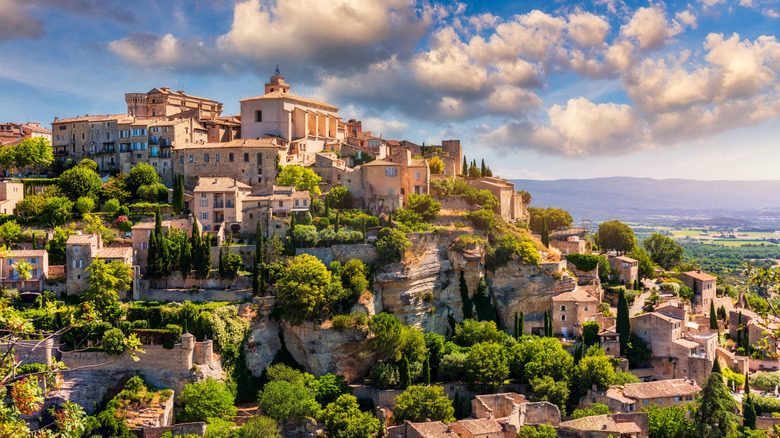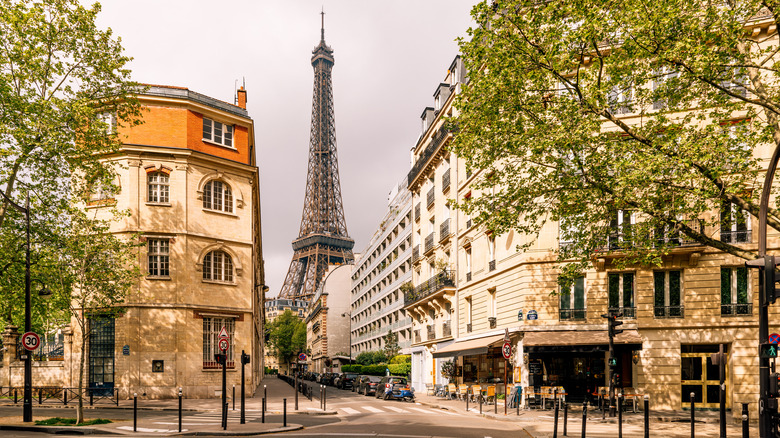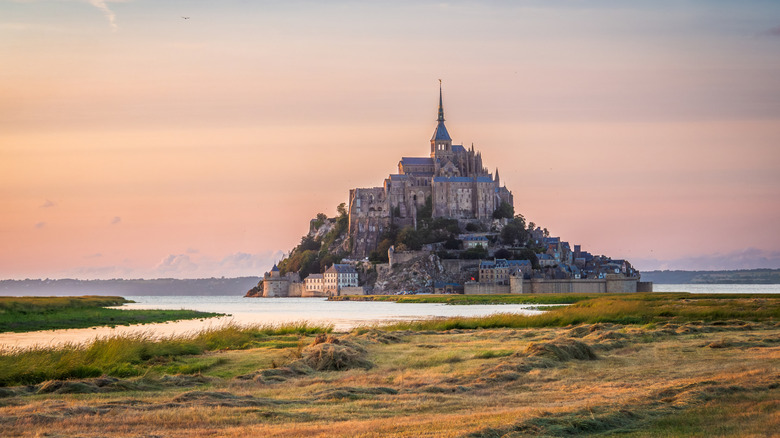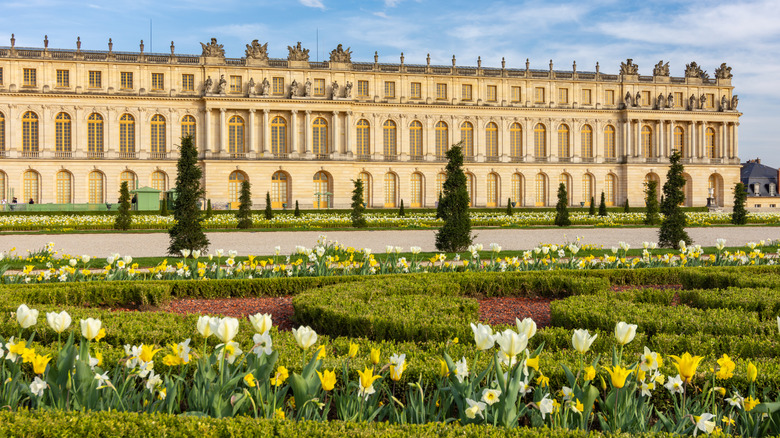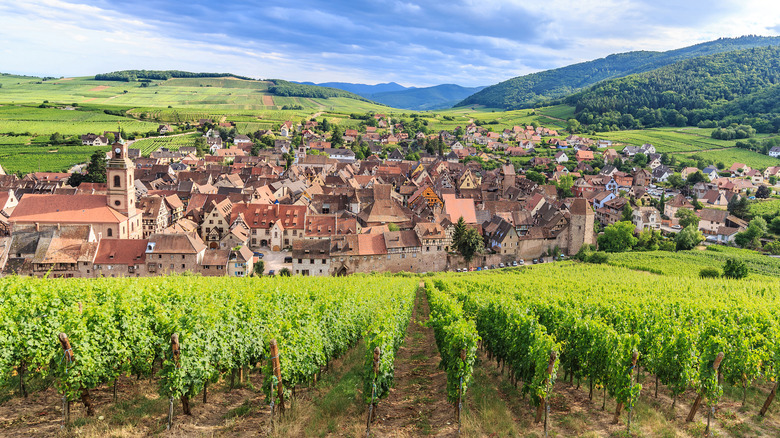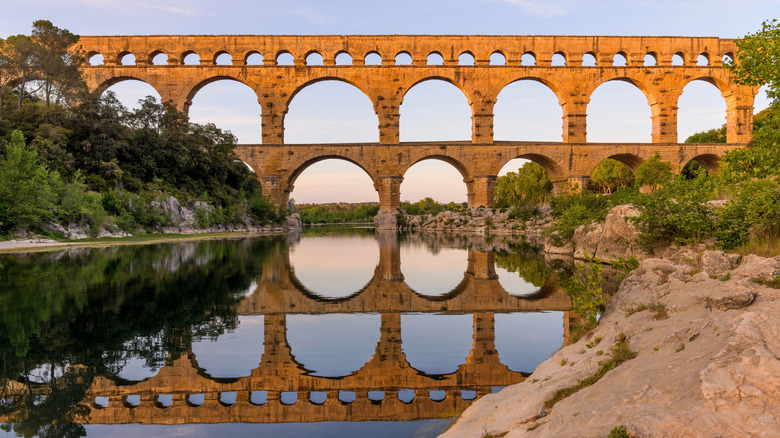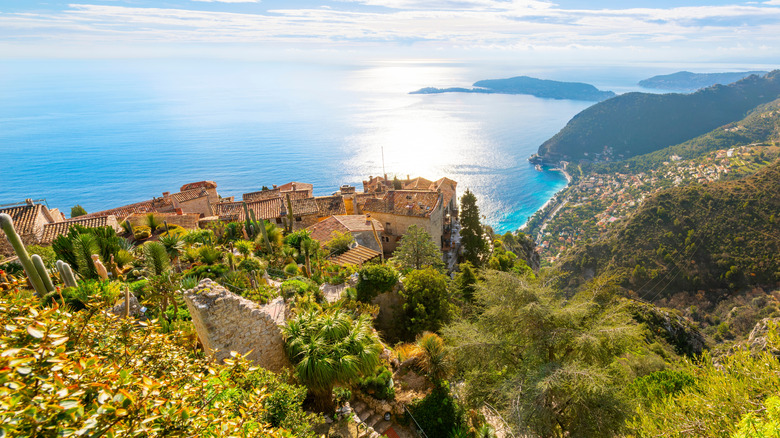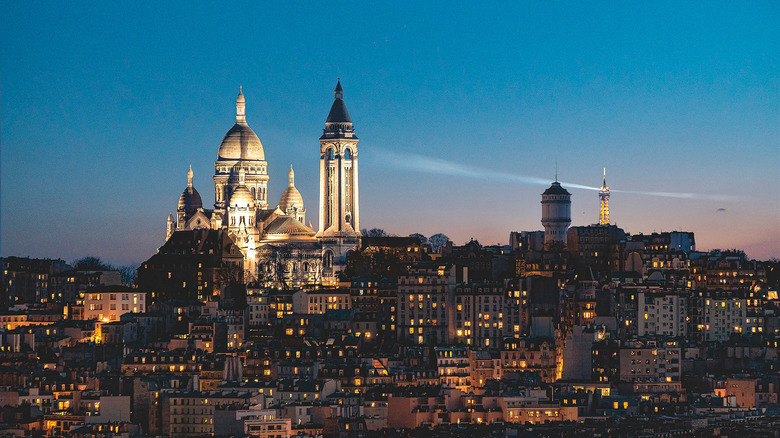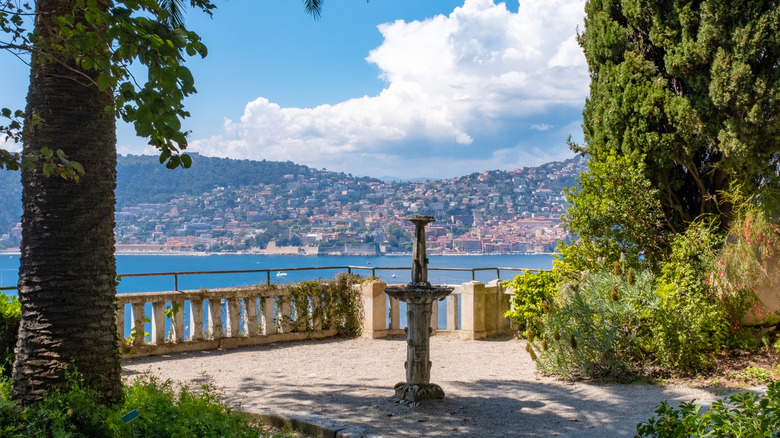France's 12 Best Destinations To Take Beautiful Pictures
With a total of 54 UNESCO World Heritage Sites sprinkled around the country, France is a veritable wonderland when it comes to grand architecture, rich history, and natural beauty. Famous châteaux, marvels of Roman engineering, expansive gardens, and iconic monuments continue to draw upwards of 100 million international visitors every year. And while a very common first stop is Paris, which is changing how visitors experience its streets, the country boasts a wide variety of sights and landscapes. When it comes to remembering your trip, whether you're interested in just snapping a few photos or taking some serious lenses along, there are more destinations in France than you'll know what to do with.
Access varies a lot by destination, as some places can be crowded or have formal hours that vary by season or day of the week. Châteaux and churches, for example, often charge admission fees and will have their own rules about taking photos inside. Often, you're able to use a camera without the flash, but guidance will typically be clearly posted when you enter. If you're a professional photographer or the images will be used for commercial purposes, you'll probably need to secure a permit, and it's a good idea to contact the location in advance of your trip.
With all that said, photo opportunities abound throughout France. And you know what they say: the best camera is the one you have with you! Far from an exhaustive list, below you'll find 12 of the most amazing places in France to take stunning pictures. In some cases, we've included a note or two about nearby detours for even more snaps that make the most of the area.
The Eiffel Tower
Let's just cut right to the chase with the Eiffel Tower, arguably the most iconic structure in France and certainly among the most recognizable in the world. Situated on the Seine and abutting a long park called Champ-de-Mars, the tower's overall height is 1,024 feet (not including antennas), and its elegant ironwork can be seen from miles around. At night, it sparkles like a giant gemstone thanks to 20,000 lightbulbs that flash randomly for five minutes at the start of every hour. Hundreds of other spotlights illuminate the structure in the dark, making this spot perfect for photos, either day or night.
One of the most popular spots for gorgeous pictures of the Eiffel Tower is Place du Trocadéro, which features grand staircases, a garden with a fountain, and a raised platform for panoramic views across the river. With a wide-angle lens, you can capture the entire view — it's a great place to take engagement or honeymoon photos. Head there early to beat the crowds. And don't miss the views from a number of nearby bridges, with their own decorative features that complement the Eiffel Tower's unique silhouette. Check out Pont d'Iena, which connects Jardins du Trocadéro to the tower, Bir-Hakeim Bridge, or the immanently elegant Pont Alexandre III. And don't forget Paris's picturesque streets. The Eiffel Tower is a brilliant focal point when viewed in the distance down Rue Saint-Dominique, Rue de l'Université, or Rue de Monttessuy.
Mont Saint-Michel
Is there a more striking silhouette in Western Europe than the holy island of Mont Saint-Michel? Situated on the coast of Normandy, the story of this UNESCO World Heritage Site dates back to A.D. 708 when a vision of the archangel Michael appeared to a local bishop, who built a sanctuary on the granite outcrop. By 966, a Benedictine commune had established the first church. It's been home to monks, used as a fortress during conflict, converted to a prison known as the "Bastille of the Seas" following the French Revolution, spared during World War II raids, and is now again home to a religious community. It's a sight to behold among the most gorgeous churches you must see in France.
Snap pictures from the Bay of Mont Saint-Michel, which fills with water at high tide and becomes crossable at low tide. Certified guides can lead you across the sand on excursions that last just an hour or two, or long-haul hikes to see surrounding sights and find a range of great views to capture, either the whole island and its unique buildings in detail. Head over the Barrage sur le Couesnon, or the dam, to frame the island above a winding canal. It's beautiful at sunset or sunrise. Or, if you want to escape the crowds and don't mind a little distance, take a 40-minute drive to Pointe du Grouin du Sud, which offers views of Mont Saint-Michel framed by the coastal landscape.
Palace of Versailles
From Louis XIII's hunting lodge to Louis XIV's grandiose home and seat of government, the Palace of Versailles is like no other royal residence on Earth. The building comprises a mindboggling 2,300 rooms, which cover more than 63,000 square meters, and all of it is done up in the dramatic, almost overwhelming ornament of the French Baroque style. In the 18th century, landscape designer André Le Nôtre also designed the château's elaborate and expansive formal gardens, which provide a gorgeous setting for photos of the palace exterior and meticulously tended foliage.
The Palace of Versailles is an immensely popular tourist destination with specific opening times, so even arriving early can mean heavy crowds. That can make getting nicely framed shots more difficult, but there are still myriad ways to capture the scale and beauty of this historic landmark. Inside, you'll have to turn your camera upward if you want to avoid including throngs of other people in famous places like the Hall of Mirrors, but outside, with room to roam, you can snap some more relaxed images. The Park is all about perspective, with long corridors and soothing symmetry. The glorious Orangerie is just below the palace, making it a great vantage point for pictures, or you can find a great spot around the Grand Canal and the Lake of the Swiss Guards. The best part is that entry to the Park is free of charge, and it's open every day.
Château de Chenonceau
On the topic of grand architecture, you won't want to miss the Loire Valley, home to dozens of historic castles, picturesque towns, and amazing wineries. This area is home to numerous amazing châteaux, each brimming with picturesque turrets, gardens, water features, and sometimes even bridges. Château de Chenonceau is among the most well-known, a breathtaking escape with gardens, priceless art, and wine tastings. Its crowning feature is a gorgeous arched bridge over the River Cher, complemented by beautiful formal gardens initiated by famous figures like Diane de Poitiers and Queen Catherine de' Medici.
From the bank of the river, capture memorable scenes of Chenonceau reflected in the water, with a backdrop of trees. In the fall, some of these turn rich ochre and orange, adding additional depth. For even more fairytale castle magic in the Loire Valley, check out further destinations like Château de Villandry, Château de Chambord, Château de Chaumont-sur-Loire, and myriad others.
Chartres Cathedral
Located in the city of Chartres, which you can reach by train in only about an hour and 15 minutes from Paris, the city's eponymous medieval cathedral is not only a UNESCO site but an astonishingly well-preserved architectural gem brimming with 12th and 13th-century features. It's also wonderfully complete — with two fully constructed, asymmetrical towers — and was historically a major pilgrimage site for Christians in the Middle Ages. It basically defines "gothic cathedral." And like other incredible ecclesiastical buildings throughout France, from the newly reconstructed Notre Dame in Paris to a cathedral of the same name in Amiens, Chartres makes for a fantastic photo-op.
It's a good idea to bring a wide-angle lens if you have one, in order to capture the entire cathedral. As it towers over many of the other buildings, it can be seen from a distance, too. Capture the cathedral and skyline from the tranquil banks of the Eure River at La Petite Venise, home to Chartres' waterfront guinguette, or outdoor cafe, which also offers pedal boats for rent. And for a bonus, visit between April and the New Year to experience Chartres en Lumières, which lights up local architecture with vibrant projections. In 2025, Chartres Cathedral will have a couple of portals artistically illuminated.
Chamonix-Mont Blanc
For a true European cultural fusion, head to Chamonix in the French Alps. Situated close to the junction of France, Switzerland, and Italy's borders, this fairytale village is where postcard-worthy chalets, ski resorts, and the range's tallest mountains converge in the Chamonix-Mont Blanc Valley. It probably goes without saying that the dramatic and rugged terrain here means you'll find photo opportunities galore, and fortunately, there are many ways to find the perfect picture.
In the summer or early autumn, enjoy challenging hiking trails to take in endless mountain views. The Tour de Mont Blanc is a renowned hiking route that covers a little more than 105 miles and crosses into each of the three countries, taking about ten days from start to finish. It's also the trail that made Rick Steves fall in love with hiking. Take on just a portion for options that are rated easy to challenging, or plan ahead and take on the whole thing! And throughout the year, you can hop aboard the Aiguille du Midi cable car right from the center of Chamonix for a truly memorable 20-minute ride up to the iconic Mont Blanc at an altitude of more than 12,600 feet. At the top, you can relax with a warm beverage from the cafeteria, check out the gift shop, or take in the view from several benches and viewpoints.
Route des Vins d'Alsace
The Route des Vins d'Alsace, or the Alsace Wine Route, is not only located in one of the most scenic, off-the-beaten-path areas of eastern France, but it's also home to some of the most charming and picturesque medieval villages around. Communes like Riquewihr and Ribeauvillé feature some of the oldest buildings and quaint cobbled streets in the country. Nestled into the hills, Ribeauvillé, for example, sits at the foot of the Three Castles of the Lords of Ribeaupierre, which were built in the 14th century to help protect the city and provide lavish dwellings for their noble inhabitants. These overlook a town with meandering streets and immanently photo-worthy timber-framed storefronts, hand-painted signs, and flower boxes exploding with color in the warmer months. Walk down Grande'Rue and detour down its many side streets for stunning views.
Just south of Ribeauvillé, around 10 minutes by car or 20 minutes by bus, sits another beautiful village along the Alsace Wine Route that hails from the Middle Ages: Riquewihr. The town center's cobble streets are easily walkable, affording stunning views of even more half-timber buildings. Sample local wine in town like those from Famille HUGEL, makers of Riesling, or head out to the countryside to enjoy the rolling, vineyard-covered landscape and stop for tastings provided by numerous other vintners.
Pont du Gard
About halfway between Avignon and Nîmes in Occitanie, a striking example of ancient Roman engineering spans the Gardon River. Pont Du Gard is the most impressive segment of a 31-mile aqueduct built in the 1st century to supply Nîmes with water from the Eure. The city is sometimes referred to as the "French Rome" for its unforgettable ancient sights. The towering, multi-level, arched bridge is 160 feet high with one level that extends 1,181 feet long. And this 2,000-year-old masterpiece also happens to make an amazing backdrop for a portrait or a composition in its own right.
The bridge is best viewed from either the riverbank or in the river itself, which is shallow and popular for swimmers and paddlers. In the early part of the day, you'll want to stand on the right bank for the best photos, and in the afternoon, take advantage of the light from the left bank. As the river has carved out a shallow gorge, you have the option of viewing the bridge from lower or upper elevations, and no matter which you choose, the view — and Pont du Gard's technical precision — is spectacular.
Eze and the French Riviera
Just east of Nice, which is a fantastic destination in its own right in southern France, make your way to the seaside town of Eze, a fairytale village perched on the hills of the French Riviera with stunning views. You'll be hard-pressed to find a vantage point for pictures of the French Riviera that rivals those you can find from Le Jardin Exotique d'Eze, which features a steep hill with tropical plants to foreground the sweeping panorama of the shoreline and sea beyond. A range of textured cacti and sunlit tile rooftops create a nature-meets-architecture mosaic against the blue of the Mediterranean, and if you point your camera westward, you'll be able to capture the Cap-Ferrat peninsula, known as the "peninsula of the billionaires," where a busy marina and beautiful, luxurious community stretch into the water.
Cap-Ferrat is also absolutely worth a visit to explore the lighthouse and historic homes like the early 20th-century pink confection that is Villa Ephrussi de Rothschild, designed in the Renaissance style and nestled within a beautiful garden. For epic Riviera scenery and a relaxing beach stroll in one, head just about 15 minutes by car along the winding, mountainous road to Mala Beach in Saint-Laurent Bay, offering stunning views of the surrounding bluffs and seaside homes.
Abbaye Notre-Dame de Sénanque
When you think of blossoming lavender fields, it wouldn't be surprising if the iconic Abbaye Notre-Dame de Sénanque pops to mind, with its rows of Mediterranean herbs nestled into the rocky Provençal hills. The beautiful abbey comprises a small church, a monks' room known as a chauffoir, a chapter house, and beautiful cloister gardens. It was founded in the 12th century, and amazingly, it's still an active monastery today.
Abbaye Notre-Dame de Sénanque is a beautiful, contemplative space both inside and out, with its elegant stonework — more than 2,700 lapidary marks have been recorded around the abbey — and its famous lavender field. Head back around the field for a beautiful view of the entire building. Alternatively, head inside to the sun-dappled cloister, where you can capture the vibrant garden through the elegant series of arches. For another outing in the Luberon mountains, book a tour that takes you through its famous "perched" villages — a photographer's dream! For half a day, your guide will provide views of Abbaye Notre-Dame de Sénanque along with places like the cascading hillside towns of Gordes and Roussillon, and the picturesque waters of Fontaine de Vaucluse.
Monet's Garden at Giverny
Over the centuries, France has produced more than its fair share of incredible artists, from Paul Cézanne to Edgar Degas to Henri Matisse — and then some. Claude Monet is, of course, also one of the nation's most well-known painters, whose Impressionist masterpieces captured now-iconic haystacks, shorelines, and gardens. Water lilies in particular struck his fascination, drawn from life in his home garden in Giverny, which is about an hour-and-a-half northwest of Paris. His garden will transport you back in time to when the world-renowned artist rendered idyllic outdoor scenes in sometimes giant oil paintings, experimenting with light and brushstrokes in a way that, at the time, was completely new.
One of the most famous views of the garden includes a gently arched footbridge, surrounded by beautiful plants and, of course, plenty of water lilies. You won't have a hard time finding great vantage points for capturing the water features and trees. Plus, a visit to the house itself won't disappoint. It gets crowded here, especially during the summer when the garden is in full bloom, so it's a good idea to book your ticket in advance to avoid long queues.
Sacré-Cœur Basilica and Montmartre
For one more not-to-be-missed stop in Paris that's fantastic for taking photos, head to Montmartre in the 18th arrondissement. This district is home not only to the famous Moulin Rouge but also to its landmark hill, topped with the gleaming, architecturally remarkable Basilique du Sacré-Cœur. The basilica alone is worth a few snaps, perched at a high point with dramatic stairways that provide great compositional elements in a picture. From the top of the hill, you can look out over Montmartre for stunning city views — the hillside is also a great place to soak up a little sun on a clear day.
Sacré-Cœur is a delight to see as it peeks out above or between buildings along some of the surrounding streets. Look for views from Rue Ferdinand Flocon, Rue Briquet, or from the bottom of Rue de Chartres, where it meets the more commercial thoroughfare of Rue de la Goutte d'Or. And if you happen to be a little south, just across the Seine, spot the basilica high on its hill through the huge transparent clock on the 5th floor of the Musée d'Orsay.
Methodology
France is undeniably a photographer's paradise, with dramatically varied landscapes, deeply historic towns and cities, famous wine country, and gorgeous coastlines. To find some of the very best places to take beautiful pictures, we relied on personal experience and local and regional information websites like TourainValdeLoire.com, TheLuberon.com, ChateauVersailles.fr, Chenonceau.com, Senanque.fr, Giverny.org, and more. We also consulted tourism and photography blogs like France-JustForYou.com, DescubreParis.com, PhotographFrance.com, MidlifeGlobetrotter.com, and TravelPhotographyGuru.com. For specific information about the history or visiting, we researched locations like ChateauVersailles.fr, Chenonceau.com, Senanque.fr, and Giverny.org, plus information provided by UNESCO. And to really help bolster what makes these destinations so great, with some additional options for places to check out, we relied on comments posted by visitors on Tripadvisor, Reddit, and Google.
